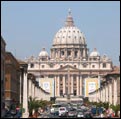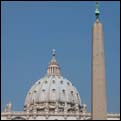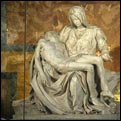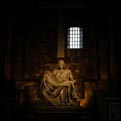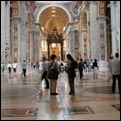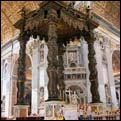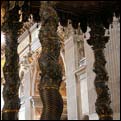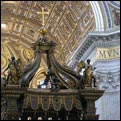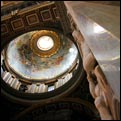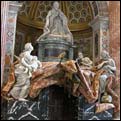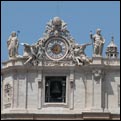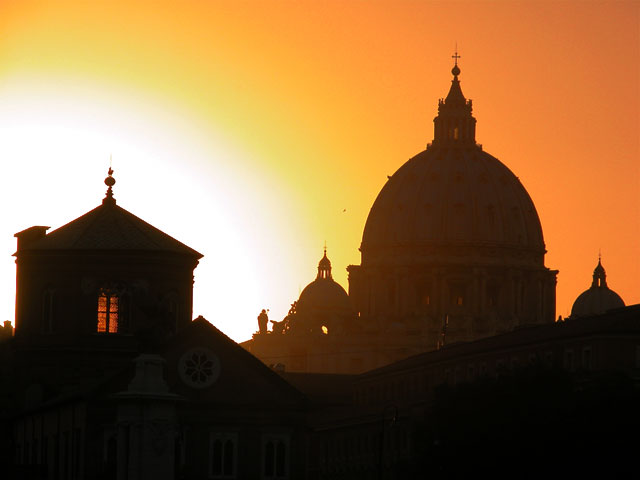
This great and magnificent temple is situated in the Vatican City where the amphitheatre of Nero was once. Tacitus relates that in this amphitheatre the cruel Emperor had a great number of Christians slaughtered and burnt alive. The merciful Christians buried the martyrs in the neighbourhood of the amphitheatre and here after a short time was placed the body of the Prince of the Apostles, St. Peter, who suffered martyrdom under Nero. In the year 324 by will of Constantine the Great, on the sepulchre of the Apostle, where there was already a little Oratorio that St. Anacletus had built there, rose the first basilica of St. Peter; -it was large and majestic. and divided into five naves by a large number of columns and beautified with frescoes and mosaics and innumerable treasures of art.
In this basilica whose splendid life lasted Qver a thousand years, were consecrated and crowned many emperors,. first of all Charles Magne, who, on Christmas day, in the year 800 receiving the imperial crown from the hands of Leo nI, was saluted with these words: «to Charles most merciful Augustus, crowned by God, great and pacific Emperor of the Romans, life and victory». In 1450 Nicholas V seeing that the Basilica, though restored many times, was on the point of failing down because of its failing foundations resolved to build it again and entrusted Architect Bernard Rossellini with the task. The latter ·began the reconstruction trying .to respect the former Basilica leaving untouched the entrance portico adorned with magnificent mosaics. In 1455 at Nicholas V's death the work was interrupted and was begun a new half a century later by Julius II who having a bent for great undertakings, chose the most colossal among the projects, Bramante's; it was the project of a temple in the shape of a Greek cross with a dome in the middle, like the dome of the Pantheon and held up by four huge pillars. To put into effect this grandiose project, Bramante began the work of demolition of the ancient Basilica without any consideration for the ancient memories and the treasures of art it contained. And for this work he got the title of Mastro Ruinante from his contemporaries.
But at the beginning of the work both Julius II and Bramante died (1513-1514); so Leo X gave the direction of the work to Raphael Sanzio who, together with Julian of Sangallo and Brother James da Verona, changed the project of the Greek cross into the Latin one, departing altogether from Bramante's project whose intention was to make visible from any point of the Basilica the huge Mausoleum that Julius II had in mind to be built for himself and situated in the middle of the Basilica. Raphael died in 1520 and was succeeded by Balthasar Peruzzi who returned to the project of the Greek cross; he was succeeded by Sangallo who returned again to the project of the Latin cross and at last Michael Angelo returned once more to the project of the Greek cross.
The latter developed, enlarged and consolidated the project of" Bramante, but he did a new design for the dome, which no longer resembled the Pantheon's "but was similar to Brunelleschi's dome of S. Maria del Fiore, completed the Basilica triumphantly to tower high and magnificent in the sky of Rome. At Michael Angelo's death (1564) only the lower part of the dome and three transepts of the church had b~en finished.
The work was continued both by Vignola and Pirro Ligorio but it was James della Porta, aided by Dominic Fontana who, under Pope Sixtus V, an energetic and determined Pope, that completed the work only in 22 months. James della Porta did not keep strictly to the design left by Michael Angelo, he enlarged and made the dome more pointed and narrowed its highest part making the whole more slender.
As Paul V wanted the work to be completed and the Basilica enlarged he returned again to the idea of the Latin cross, choosing among many projects the· one of Charles Maderno who is also the author of the fac;ade. Maderno added three chapels respectively on both sides making the Basilica larger but sensibly .diminishing the effect of the dome. Urban VIII consacrated the new temple on the 18th November 1623, 1300th anniversary of its first consecration. Maderno was succeeded by Bernini who took up the direction .of the works in 1629 giving in many parts a baroque style to the Basilica and creating the magnificent colonnade which adorns the most beautiful square in the world. Considering the number of Popes and architects who worked at t.he construction 'of the Basilica and the three centuries and a half to end it we can form an idea of the large sums required to build this huge Basilica, the most complete and large master-piece ever built. All the arts have contributed to decorate thie grandiose building, which is undoubtedly the most wonderful monument in the world and expressed through the wonderful tongue of art the triumphant universality of the Church of Rome..
THE PORTICO.
The facade has five doors leading tho the grandiose Portico, 71 metres long and 43 metres wide. At the end, on the right, there is the statue of the Emperor Constantine by Bernini, on the left Charles Magno's by Comacchini. Behind the principal entrance, on the top, there is the celebrated mosaic The little ship of St. Peter by Giotto. It was transferred from the ancient Basilica and represents Jesus walking on the water; the ship with the Apostles is the symbol of the Church, it has . been retouched many times. Of the five doors leading to the Church, the central bronze one, is adorned with bas-reliefs by Filarcke (1445) representing the martyrs of St. Peter and St. Paul, the coronation of the Emperor, the audience of the Pope to the Western nations. The last door on the right is the Holy Door which is opened only in the holy years by the Pope himself with a solemn ceremony.
THE INSIDE.
The first impression is grandiose but not as it should be, as the Latin cross formation of the Church and the accurate proportion of all the parts diminuishes the impression which is by far stronger looking from the transepts. The total lenght is 185,37 metres, while St. Paul's in London is 15-7,20 metres.
Florence Cathedral's lenght is 149,28 metres and Milan Cathedral's length is 134,17 metres.
These measures marked on the central floor show that this temple is the largest in the world. Immediately after the central part, on the floor there is the huge dise of porphyr carried here from the ancient church, on which Charles Magne on his kneels received the crown of Emperor of the West from Pope Leo III (in the year 800).
The central nave has four grandiose arcades, each supported by graved Corinthian pillars 24,80 metres high supporting a large entablature, on a design by Michael Angelo and the vault decorated with coffers in golden plaster. On the top in the nooks, there are the statues of the founders of religious orders, whose names are written on the bases; all works of good sculptors (Valle, Rusconi, Bracci etc.). On both sides are the two Holy water basins in yellow marble in the shape of a shell; to remark the two angels, supporting them, 2 metres high.
On the right at the end of the central nave there is the celebrated statue of St. Peter whose foot all the religious people of the whole world come and kiss. According to the tradition this statue was got from the fusion, of Jupiter Capitoline, while on the contrary the work is thought to he by Arnolf di Cambio (XIII century). In great solemnities the statue is covered with precious ornaments. Over it there is the portrait in mosaic of Pius IX, who was the first after St. Peter, to reach the 25th year of reign. Then there is the dome supported by four huge pillars whose inside is 119 metres high. The diameter is 42 metres, each pillar has a perimeter of 11 metres. Over the decoration of the pillars there is the inscription: « Tu es Petrus et super, hanc petram aedificaho ecclesiam meam et tibi daho claves regni coelorum ». Higher there is the lower part of the dome with 16 windows; lastly the vault also divided into 16 compartments adorned with mosaics and golden plasters. In the corners of the dome there are the four Evangelists. In the nooks of the pillars there are four grandiose statues: St. Longinu's who opened Jesus's chest with his lance (Bernini's);' St. Helene, the Emperor Constantine's mother with the relics of the Cross (Bolgi's); St. Veronica showing the shroud with the image of the Saviour (Mochi's); St. Andrew by Duquenoy. The lodges over the statues are. adorned with spiral marble columns, taken from the ancient Basilica.
Of them during the Holy week the Saint relics of Christ's Pas6ion are exposed.
In the middle there is the canopy protecting the High Altar situated on the sepulchre .of the Apostle where only the Pope can say mass.
The canopy is a remarkable work by Bernini, a very original creation which ingeniously resolves the problem of not covering the back of the Church and of giving to the protection of the altar a mien of lightness as well as of majesty. The bronze columns in spiral, are adorned with vine-leaves; the metal was got from the one adorning the beams of the portico of the Pantheon. Below, the Confession, the sepulchre of St. Peter designed by Maderno 'and adorned with rich marbles; around it there burn in perpetuity 95 lamps adorned with bronze.
The double staircase leads to the tomb, where is kneeling Pius VI, a wonderful work by Canova (1822). So the visitors comes back to the entrance beginning the visit to the naves. On the right there stands the Chapel of Piety, so-called from the group of Piety by Michael Angelo, a juvenile work, inspired to a sad sweetness, the only work having the author's signature.
On the right of the altar there stands the column in spiral which is, according to the tradition, the one of the temple of Solomon on which Jesus leant during the debate with the doctors. The vault of the chapel represents the thriumph of the Cross, by Lanfranco.
Going on, on the left there is the sepulchre of Queen Christina of Sweeden turned a catholic in 1655. It is a work by Fontana. On the light there stands the sepulchre of Leo XII by Fabris _(1836) under which there is a chapel, said of the Crucifix, which is attributed to Peter Cavallini.
In the second passage, there is the chapel of St. Sebastian with the mosaic of the altar which reproduces a painting by Domenichino of the Church of St. Maria degli Angeli.
In the passage, on the right there stands the sepulchre of Innocent XIII (by Philip Valle), on the left there are the tombs of the celebrated countess Mathilde of Toscana from a design by Bernini. The bas-relief represents the scene of Canossa with the submission of the Emperor Henry IV to pope Gregory VII (St. Speranza). The large chapel on the right, said of the Sacrament, has on the altar a large, wonderful tabernacle in golden bronze by Bernini, and the painting of the St. Trinidad by Peter da Cortona. On the right there is the reproduction in mosaic of a painting, the Extasy of St. Francis.
In the third passage, on the right there stands the monument of Gregorius XIII (Rusconi) with the bas-relief reminding the reform of the calendar made ·by the Pope in 1582. On the left the tomb of Gregory XIV, from which there lacks the statue. At the end of the nave, there is the mosaic of the famous painting of Domenichino, the Communion of St. Jerome, which is to be found now in the Vatican gallery.
The next chapel, the Blessed Virgin Mary's, also called Gregorian, was designed by James della Porta, it is rich in precious marbles, with the ancient image of the Virgin of the Succour. There is also the tomb of pope Gregory XIV by L. Amici with the statues of Wisdom and Prudence and a bas-relief representing the propagation of Faith. In the passage on the right there is the tomb of Benedit XIV (P. Bracci) with the statues of Wisdom and Disinterestedness (G. Sibilia). The mosaic of the Altar, on the left, reproduces the painting of Subleyras, St. Basil's Mass which is found at present at St. Maria of Angeli. In the right transept there are three mosaics reproducing St. Wenceslas (Caroselli), Process and Martinian (Valentino), St. Erasmus (Poussier). In the nooks there follow the statues of the founders . of religious orders. In the following passage, on the right there stands the celebrated monument of Clemens XIII by Canova.
The statue of the Pope kneeling down, is sided by the Genius of Death and by Religion; on the fore part the two figures in has -relief: Charity and Hope, famous for the wonderful make of the two lions. On the right there is the mosaic from a painting by Lanfranco, St. Peter walking on the waves.
The last chapel on the right, St. Michael's, with the reproduction in mosaic of a painting of Guy Reni, of the Church, of the Capuchins and St. PetroniIla's by Guercino, of the Capitoline gallery.
Going towards the central apse the visitor sees the tomb of Clemens X by Hercules Ferrata with the bas-relief reproducing the opening of the Holy Door in the year 1675. In front of it, the miracle of St. Peter from the painting of P. Costanzi.
The apse is one of most characteristic creations of the Baroque style of Bernini. Four Saint Doctors of the Church supporting the Chair of St. Peter, in golden bronze, enclosing the very ancient one attributed according to the tradition, to St. Peter; it is in wood and ivory and is surrounded by four angels also in bronze. Above it a glory in golden piaster in the midst of which the window with yellow panes with the symbol of the Holy Ghost in the shape of a dove. On both the sides of the Chair there stand the two celebrated sepulchral monument of Paul III Farnese and of Urban VIII.
The monument of Paul III Farnese, a work by William della Porta, after the manner ofMichael Angelo; the statue of the pope is in bronze. It is sided by the magnificent statues of Justice and Prudence, the former is said to represent the pope's sister, Julia Farnese, the latter the pope's mother (Giovannella Caetani).
The statue of Urban VIII also in bronze, is a work by Bernini, the two statues. represent Charity and Justice.
In the passage after the tribune there is the tomb of Alexander VIII Ottoboni (1691) in bronze, by A. de Rossi; on the left the mosaic of St. Peter effecting the recovery of the paralytic patient from a painting of Francis Mancini.
There follows the Chapel of the Column, so-called from an ancient image of the Our Lady, painted on a column and brought from the ancient church.
On the opposite altar a has-relief of great value by Algardi, representing pope Leon Magnus persuading Attila not to attack Rome, under the altar there are the relics of the pope and the tombs of his successors Leon II, III and IV.
Proceeding to the transept there is the tomb of Alexander Chigi, the last work of Bernini: the statues represent Justice, Prudence, Charity and Verity. To remark the original funeral qUilt i. jasper marble lifted by Death. On the left the modern mosaic of the Sacred Heart of Jesus.
In the left transept there are three paintings in mosaic. The first, on the left represents the martyrs St. Martial and St. Valeria, the one in the midst, the Crucifixion of St. Peter, from a painting by Guy Reni; on the right·there is the Incredulity of St. Thomas.
In this transept there are many confessionaries in several languages, from which the penitentiary touches with a long stick the faithful, kneeling down in sign of humility.
In the passage there is the monument to Pius VIII by P. Tenerani (1866) with the statues of the Apostles Peter and Paul interceding for the safety of the Pope.
Under the monument there is the entrance to the sacristy. On the altar on the right there is the mosaic representing the chastisement of Saphira who would lie to the Apostles, from a painting by Pomarancio at St. Maria of Angeli's.
The Clementine Chapel with the altar and the tomb of St. Gregory Magnus, the mosaic was taken from a painting by Andrew Sacchi. Opposite to it, is the monument to Pius VII by Thorwaldeen, built by order of Cardinal Consalvi with the statues of Wisdom and Fortitude.
Proceeding towards the central aisle behind the large pillar there is the copy in mosaic of the Transfiguration by Raphael, the famous painting of the Vatican gallery. In the passage to the right aisle, there is the monument to pope Innocent XI by Stephan Monnet: the bas-relief represents the deliverance of Vienna from the besiege of the Turks effected by John Sobieski.
On the right, the tomb of Leo XI who reigned only 24 days, by Algardi, the bas-relief reminds the abjuration of the king of France. There follows the large chap.el of the choir with the seats for the canons celebrating their ordinary functions; it is adorned with mosaics and precious plasters. On the altar there is the Immaculate Conception from a painting by P. Bianchi.
In the passage on the right there is the monument to Pis X (by P. E. Astorri), with bas-reliefs representing the most important events of his pontificate.
The tomb of Innocent VIII (Cibo) by Anthony Pollaiolo. The pope is represented when alive and after his death. This monument was taken from the ancient Basilica.
The following chapel is. said to be of the Presentation, from the painting in mosaic on the altar, after the original one by F. Romanelli, at
St. Maria of Angeli's. On the left, the monument of Benedict XV by P. Canonica:. In the background there are some paintings representing the horrors of the great war (1914-1918); proceeding under the arcade, on the right top, there is the tomb of Clementine Sobieski Stuart by P. Bracci, the portrait is. in mosaic and is by P. Cristofer. The door below leads to the staircase leading to the dome.
Opposite to it, the tomb of the last Stuarts, wonderful work by Canova with very beautiful weeping angels.
The last .chapel is the one of the Baptism. The conch is thought to have come from the tomb of the Emperor Otto II, the ornaments in bronze are by C. Fontana. The three mosaics derive respectively from the paintings of Charles Maratta (The baptism of Jesus), of G. Passeri (St. Peter christening in prison St. Process and St. Martinian), of A. Procaccini (The baptism of Cornelius).
Ending the visit to the great Basilica, the ideal centre of the Christian world and the secular aim of hope and faith, the mind of the visitor gets exited with a sublime enthusiasm and a deep emotion.
TILDE BARDI - A GUIDE TO THE GREAT ROMAN MONUMENTS - 1945

